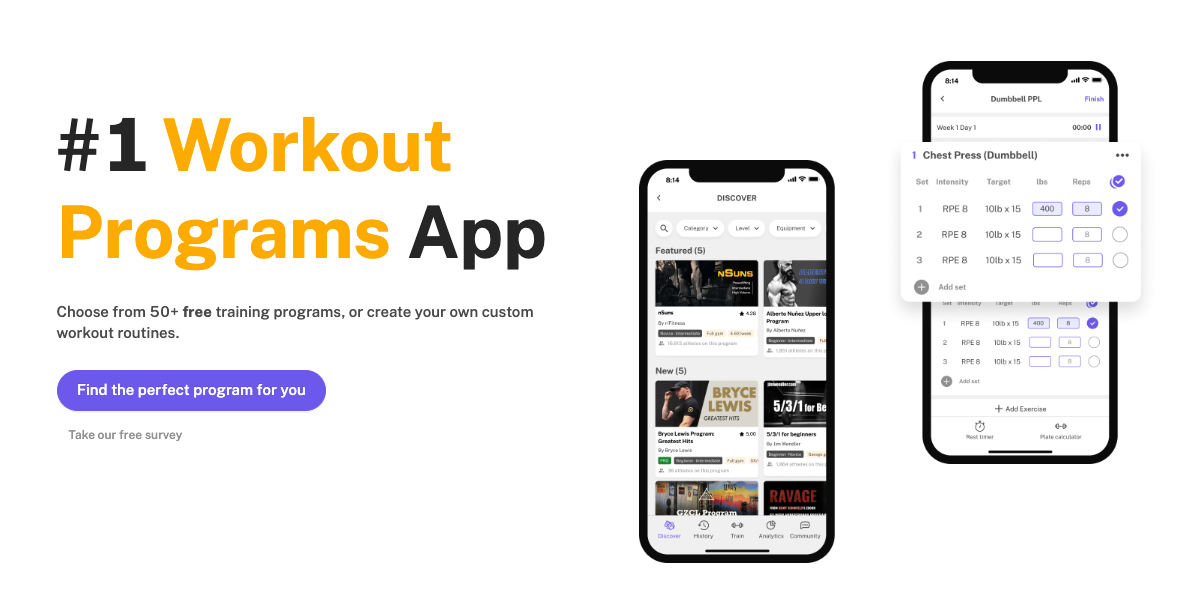The Best Rep Ranges for Building Muscle vs. Building Strength
Written by The Boostcamp Editors
Are you training properly for your goals?
When it comes to resistance training, achieving specific fitness goals—whether it’s building muscle mass (hypertrophy) or increasing strength—depends significantly on the number of repetitions (reps) and the amount of weight used in each set. Both goals involve different adaptations in the body, leading to differences in the recommended rep ranges for each.
Understanding these differences can help you tailor your workouts for maximum results, so let’s take a look at the differences in rep ranges when it comes to training for strength vs. hypertrophy.
The Science Behind Rep Ranges

Before diving into the best rep ranges, it’s essential to understand how rep ranges influence muscle growth and strength development. Reps reflect the intensity and volume of your workout, and training in different rep ranges activates different types of muscle fibers and energy systems.
Strength Training primarily targets the nervous system, focusing on maximal force production.
Muscle Building (Hypertrophy) aims to increase the size of the muscle fibers by inducing muscle damage and metabolic stress.
Best Rep Range for Building Muscle (Hypertrophy)
To optimize muscle hypertrophy, most experts recommend a moderate rep range, typically 6-12 reps per set. This range provides a balance between creating tension on the muscles and accumulating enough volume to promote growth.
Why 6-12 Reps?
Mechanical Tension and Time Under Tension: This range generates sufficient tension to stimulate growth while keeping the muscles under load long enough to cause fatigue and muscle damage.
Muscle Damage: Performing 6-12 reps creates micro-tears in the muscle fibers, triggering a repair process that leads to muscle growth.
Metabolic Stress: This rep range leads to a higher accumulation of metabolic by-products like lactate, which promote hypertrophy through cell swelling and signaling for growth.
Sufficient Volume: Volume (sets x reps x weight) is crucial for hypertrophy. Working in the 6-12 rep range allows you to lift moderate-to-heavy weights while still performing enough reps to induce growth.
Practical Example:
Bench Press: 4 sets of 8 reps at 70-80% of your one-rep max (1RM).
Squats: 4 sets of 10 reps at 70% of 1RM.
Best Rep Range for Building Strength
Strength development is best achieved in a lower rep range, typically 1-5 reps per set, using heavier weights (85% or more of your 1RM).
Why 1-5 Reps?
Maximal Force Production: Low rep ranges emphasize the ability to produce maximal force. By lifting heavy weights for fewer reps, you train your body to recruit more muscle fibers, especially type II (fast-twitch) fibers, which are critical for strength.
Neuromuscular Adaptations: Strength training enhances motor unit recruitment and synchronization, improving your ability to lift heavier weights over time.
Optimal Load: This rep range allows you to lift near-maximal weights, which is essential for increasing strength.
Minimal Fatigue: Short sets reduce muscle fatigue, allowing full recovery between sets, so you can consistently lift heavy weights at peak intensity.
Practical Example:
Deadlift: 5 sets of 3 reps at 90% of 1RM.
Overhead Press: 4 sets of 5 reps at 85% of 1RM.
Key Differences: Building Muscle vs. Building Strength
Rep Range:
Hypertrophy: 6-12 reps
Strength: 1-5 reps
Weight (% of 1RM):
Hypertrophy: 65-80%
Strength: 85% or more
Primary Goal:
Hypertrophy: Increase muscle size
Strength: Maximal force production
Muscle Fibers Targeted:
Hypertrophy: Mix of type I (slow-twitch) and type II (fast-twitch) fibers
Strength: Primarily type II (fast-twitch) fibers
Training Focus:
Hypertrophy: Volume, muscle damage, and metabolic stress
Strength: Maximal load, neuromuscular efficiency
Rest Periods:
Hypertrophy: Shorter rest (30-90 seconds)
Strength: Longer rest (2-5 minutes)
Adaptations:
Hypertrophy: Increased muscle size
Strength: Enhanced motor unit recruitment and increased force production
Can You Build Both Muscle and Strength Simultaneously?

Yes, it is possible to build both muscle and strength, but your training needs to be periodized or designed strategically to target both adaptations. For example:
Periodization: Focus on strength training (1-5 reps) for 4-6 weeks, followed by a hypertrophy phase (6-12 reps) for another 4-6 weeks. This allows you to maximize strength gains while also building muscle size.
Concurrent Training: Some programs, like the push-pull-legs split or linear progression models, incorporate both hypertrophy and strength-focused rep ranges within the same week.
One excellent way to follow these types of programs is by using Boostcamp, a workout app and platform that offers a variety of training programs. Whether you're focused on hypertrophy, strength, or a combination of both, Boostcamp has customizable programs designed by experts. From beginner-friendly routines to advanced programs like 5/3/1 or nSuns, Boostcamp makes it easy to follow proven, results-driven plans.
Boostcamp’s user-friendly platform allows you to find programs that align with your specific goals, be it muscle growth, strength, or general fitness. It also tracks your progress over time, making it ideal for those who are serious about achieving long-term results. Whether you’re a beginner or advanced lifter, Boostcamp provides science-backed, tested programs that cater to different needs and fitness levels.
The Middle Ground: 3-5 Rep Range
The 3-5 rep range is a middle ground, often used in strength-focused programs, but it can also stimulate muscle growth, especially for beginner and intermediate lifters. The heavy weights promote mechanical tension, while the higher rep count compared to 1-2 reps still allows for significant muscle-building volume.
For those seeking a hybrid approach, programs like StrongLifts 5x5 or Starting Strength—both available on Boostcamp—emphasize this middle-ground rep range. These routines primarily focus on compound lifts such as squats, deadlifts, and bench presses, making them effective for improving both strength and muscle size.
Rest Periods: Another Important Variable
In addition to rep ranges, rest intervals between sets play a critical role in optimizing results. For hypertrophy, shorter rest periods (30-90 seconds) maximize metabolic stress and fatigue. For strength, longer rest intervals (2-5 minutes) allow for full recovery, so you can maintain high intensity throughout your workout.
Boostcamp’s programs often provide detailed guidance on rest periods, ensuring that you’re optimizing recovery and intensity based on your goals.
Conclusion
For Building Muscle: The best rep range is 6-12 reps per set, using moderate weights and short-to-moderate rest intervals to maximize muscle tension and metabolic stress.
For Building Strength: The optimal rep range is 1-5 reps per set, with heavier weights and longer rest periods to prioritize neuromuscular efficiency and maximal force production.
Both rep ranges have distinct advantages. Incorporating both strength and hypertrophy-focused training into your routine will lead to well-rounded gains in muscle size and strength. It’s important to understand the differences between the two approaches and adapt your workout accordingly.
For those who want structured guidance, Boostcamp is a highly recommended platform. It offers a variety of workout programs that cater to all types of fitness goals, whether your primary focus is strength, hypertrophy, or a combination of both. Boostcamp simplifies training by providing detailed, scientifically-backed programs that help you stay consistent and progress toward your fitness objectives.
By understanding the importance of rep ranges and following a well-designed plan, you’re well on your way to achieving your muscle and strength-building goals.
Boostcamp has plenty of free programs that help with both strength and hypertrophy, be sure to check them out and follow Boostcamp on Instagram and subscribe on YouTube!


